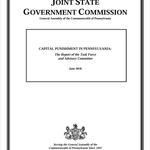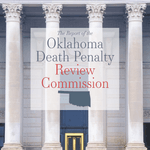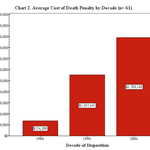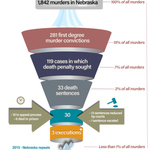
Costs
State Studies on Monetary Costs
2022

Ohio
Ohio AG Capital Crimes Annual Report (2022) cites the Ohio Legislative Service Commission’s statement that” “A mix of quantitative and qualitative studies of other states have found that the cost of a case in which a death penalty has been sought and imposed is higher, perhaps significantly so, than a murder case in which life imprisonment has been imposed.” These studies generally support the conclusion that the total amount expended in a capital case is between two and a half and five times as much as a noncapital case. The AG Report concludes that if these estimates apply to Ohio, then the extra cost of imposing the death penalty on the 128 inmates currently on death row might range between $128 million to $384 million.
2019

Wyoming
In 2019, the Wyoming State Legislature Legislative Services Office (LSO) assembled this Fiscal Report in response to the 2018 introduction of death penalty abolition bill HB189. Based on information provided by the state public defender’s office, the Wyoming Department of Corrections, and the Wyoming Supreme Court, the LSO estimated that were the death penalty to be eliminated, the state would have saved $725,000 in each of fiscal years 2019 and 2020 and $875,000 in fiscal year 2021. The LSO also estimated that $1,250,000 in additional funds would be required over that budgeted for fiscal years 2019 – 2021 “due to a current court ordered capital case.”
2018

Pennsylvania
The Joint State Government Commission of the General Assembly of the Commonwealth of Pennsylvania, Report of the Task Force and Advisory Committee, released June 2018, found “[t]here is a significant difference between the cost of the death penalty compared to life in prison without parole, primarily because of more extensive litigation and higher correctional cost for those sentenced to execution[.]” To try to assess whether there are significantly different costs between these two penalties, researchers sent out surveys electronically to judges, prosecutors, public defenders and victim advocates in nine Pennsylvania judicial districts of varying population sizes and caseloads that had past or current capital murder cases. In its conclusion, the Task Force cited to a 2016 study of death penalty costs by The Reading Eagle (see below for more detail) which estimated that $272,000,000 had been spent per execution in Pennsylvania since 1978. The Task Force also found that post-conviction correctional costs were 47% higher on average in capital cases than non-capital cases, and that there is no evidence that “guilty pleas for capital murder cases offset the extra costs incurred and other resources consumed for capital cases that do not result in a guilty plea.”
2017

Oklahoma
A 2017 independent study — An Analysis of the Economic Costs of Capital Punishment in Oklahoma — estimated that an Oklahoma capital case cost $110,000 more on average than a non-capital case.1
The study, prepared for the Oklahoma Death Penalty Review Commission researched the costs of seeking and imposing the death penalty in Oklahoma, and found that seeking the death penalty in Oklahoma “incurs significantly more time, effort, and costs on average, as compared to when the death penalty is not sought in first degree murder cases.” The study determined that Oklahoma capital cases cost 3.2 times more than non-capital cases on average. Reviewing 15 state studies of death-penalty costs conducted between 2000 and 2016, the study found that, across the country, seeking the death penalty imposes an average of approximately $700,000 more in costs than not seeking death. The researchers wrote that “all of these studies have found … that seeking and imposing the death penalty is more expensive than not seeking it.” The Oklahoma study also reviewed 184 first-degree murder cases from Oklahoma and Tulsa counties in the years 2004 – 2010 and analyzed costs incurred at the pre-trial, trial, sentencing, and post-sentencing (appeals and incarceration) stages. Oklahoma capital appeal proceedings cost between five-and-six times more than non-capital appeals of first-degree murder convictions. The researchers said their results were “consistent with all previous research on death-penalty costs, which have found that in comparing similar cases, seeking and imposing the death penalty is more expensive than not seeking it.” They concluded: “It is a simple fact that seeking the death penalty is more expensive. There is not one credible study, to our knowledge, that presents evidence to the contrary.”

New Mexico
A 2017 Fiscal Impact Report prepared by the Legislative Finance Committee of the New Mexico legislature estimated that bringing back the death penalty for three types of homicides in the state would cost as much as $7.2 million over the first three years.2
The report notes that “[b]etween 1979 and 2007 when the death penalty was an option to prosecutors, there were over 200 death penalty cases filed, but only 15 men sentenced to death and only one execution.” The Law Offices of the Public Defender reports that the defense costs for the two New Mexico death-penalty cases that remain in the system following the prospective repeal of the state’s death-penalty statute have been $607, 400 for one case and $1.3 million for the other. The Fiscal Impact Report also contains a survey of costs incurred by a number of other states in administering their death-penalty statutes.
2016
Oregon
A 2016 study by Lewis & Clark Law School and Seattle University found that 61 death sentences handed down in Oregon cost taxpayers an average of $2.3 million, including incarceration costs, while 313 aggravated murder cases cost an average of $1.4 million.3
The study, which examined the costs of hundreds of murder and aggravated murder cases in Oregon, concluded that “maintaining the death penalty incurs a significant financial burden on Oregon taxpayers.” The researchers found that the average trial and incarceration costs of an Oregon murder case that results in a death sentence are almost double those in a murder case that results in a sentence of life imprisonment or a term of years. Excluding state prison costs, the study found, cases that result in death sentences may be three-to-four times more expensive. Excluding state prison costs, the difference was even more stark: $1.1 million for death sentences vs. $315,159 for other non-capital cases. The study also found that death-penalty case costs have escalated over time, from $274,209 in the 1980s to $1,783,148 in the 2000s. The study examined cost data from local jails, the Oregon Department of Corrections, the Office of Public Defense Services, and the Department of Justice, each of which provided information on appeals costs. Prosecution costs were not included because the District Attorney’s Office budgets were not broken down by time spent on each case. Among the reasons cited for the higher cost in death-penalty cases were the requirement for appointment of death-qualified defense lawyers, more pre- and post-trial filings by both prosecutors and the defense, lengthier and more complicated jury-selection practices, the two-phase trial, and more extensive appeals once a death sentence had been imposed. Professor Aliza Kaplan, one of the authors of the study, said, “The decision makers, those involved in the criminal justice system, everyone, deserves to know how much we are currently spending on the death penalty, so that when stakeholders, citizens and policy-makers make these decisions, they have as much information as possible to decide what is best for Oregon.” Oregon has carried out only two executions since the death penalty was reinstated, both of prisoners who waived their appeals. The state currently has a moratorium on executions.
Nebraska
A 2016 study of the costs of Nebraska’s death penalty by Dr. Ernest Goss, a Creighton University economics professor who founded the conservative think tank, Goss & Associates, found that the state spends $14.6 million per year to maintain its capital punishment system.4
The study “The Economic Impact of the Death Penalty on the State of Nebraska: A Taxpayer Burden?” estimated that each death-penalty prosecution cost Nebraska’s taxpayers about $1.5 million more than a life-without-parole prosecution. Conducting a meta-analysis of cost studies conducted across the country, Dr. Goss estimated that the death penalty costs states with capital punishment an average of $23.2 million more per year than those with alternative sentencing. The study found that states with the death penalty spend about 3.54% of their overall state budgets on courts, corrections, and other criminal-justice functions associated with the death penalty, while states without the death penalty spend about 2.93% on those functions. 1,842 homicides were committed in Nebraska between 1973 and 2014, with prosecutors seeking death 119 times and obtaining 33 death sentences. Of those sentenced to death, the study found that 13 had their sentences reduced, six died in prison, three were executed, one sentence was vacated, and ten are still appealing their sentences. The study was commissioned by Retain a Just Nebraska, an organization advocating for Nebraskans to vote to retain the Nebraska legislature repeal of the state’s death penalty in the November 2016 election.

Pennsylvania
In a 2016 article, The Reading Eagle used data from a 2008 study by the Urban Institute to show that Pennsylvania has spent an estimated $272 million per execution since the Commonwealth reinstated its death penalty in 1978.5
According to the article, the Eagle calculated that cost of sentencing 408 people to death was an estimated $816 million higher than the cost of life without parole. The estimate is conservative, the paper says, because it assumes only one capital trial for each defendant and it does not include the cost of cases in which the death penalty was sought but not imposed. An earlier investigation had estimated a cost of at least $350 million, based on the 185 prisoners who were on death row as of 2014, but additional research into the cases that had already been overturned, or in which prisoners died or were executed prior to 2014, revealed a total of 408 people who had been sentenced to death.
2015
Indiana
Two 2015 state analyses of the costs of the death penalty in Indiana found that “the out-of-pocket expenditures associated with death-penalty cases were significantly more expensive than cases for which prosecuting attorneys requested either life without parole or a term of years.”
The first analysis—prepared by the Legislative Services Agency for the General Assembly on April 13, 2015, as a cost assessment for a bill that would make more cases eligible for the death penalty — found that the average cost of a capital-murder case tried before a jury was $789,581, more than 4.25 times greater than the average cost of a murder case tried to a jury in which the prosecution sought life without parole ($185,422). The analysis also found that a death-penalty case resolved by guilty plea still cost more than 2.33 times as much ($433,702) as a life-without-parole case tried to a jury.
A second analysis—prepared on May 4, 2015, in connection with a bill to add another aggravating circumstance to the state’s death-penalty statute — found that the state share of out-of-pocket expenditures for death-penalty cases tried to a jury ($420,234) was 2.77 times greater than its share of expenditures in life-without-parole case tried to a jury ($151,890). It also found that death-penalty cases tried to a jury costs counties an average of $369,347 in out-of-pocket expenditures, 11 times more than the average county expenditure for a life-without-parole case tried to a jury ($33,532). The assessment found that death-penalty cases resolved by a plea agreement are still significantly more expensive than non-capital cases that go to trial. The $148,513 average expenditure counties paid for capital cases that were resolved by plea was 4.43 times more than their average expenditure for a life-without-parole case tried to a jury.
Washington
A 2015 Seattle University study examining the costs of the death penalty in Washington found that each death penalty case cost an average of $1 million more than a similar case where the death penalty was not sought.6
The study found defense costs were about three times as high in death-penalty cases and prosecution costs were as much as four times higher than for non-death penalty cases. Criminal Justice Professor Peter Collins, the lead author of the study, said, “What this provides is evidence of the costs of death-penalty cases, empirical evidence. We went into it [the study] wanting to remain objective. This is purely about the economics; whether or not it’s worth the investment is up to the public, the voters of Washington and the people we elected.” (Although Washington’s death penalty was reinstated in 1981, the study examined cases from 1997 onwards. Using only cases in the study, the gross bill to taxpayers for the death penalty will be about $120 million. Washington has carried out five executions since reinstatement, implying a cost of $24 million per execution. In three of those five cases, the inmate waived parts of his appeals, thus reducing costs.) The study was not able to include the likely higher yearly incarceration costs for death row inmates versus those not on death row.
2014
Nevada
In 2014, the Nevada Legislative Auditor estimated the cost of a murder trial in which the death penalty was sought cost $1.03 to $1.3 million, whereas cases without the death penalty cost $775,000.7
The study, commissioned by the Nevada legislature, found that the average death penalty case costs a half million dollars more than a case in which the death penalty is not sought. The auditor summarized the study’s findings, saying, “Adjudicating death-penalty cases takes more time and resources compared to murder cases where the death-penalty sentence is not pursued as an option. These cases are more costly because there are procedural safeguards in place to ensure the sentence is just and free from error.” The study noted that the extra costs of a death-penalty trial were still incurred even in cases where a jury chose a lesser sentence, with those cases costing $1.2 million. The study was based on a sample of Nevada murder cases and include the costs of incarceration. Because certain court and prosecution costs could not be obtained, the authors said the costs were, “understated,” and may be higher than the estimates given.
Kansas
A 2014 Kansas Judicial Council study examining 34 potential death-penalty cases from 2004 – 2011 found that defense costs for death penalty trials averaged $395,762 per case, compared to $98,963 per case when the death penalty was not sought.8
According to the study, defending a death-penalty case costs about four times as much as defending a case where the death-penalty is not sought. Costs incurred by the trial court showed a similar disparity: $72,530 for cases with the death penalty; $21,554 for those without. Even in cases that ended in a guilty plea and did not go to trial, cases where the death penalty was sought incurred about twice the costs for both defense ($130,595 v. $64,711) and courts ($16,263 v. $7,384), compared to cases where death was not sought. The time spent on death cases was also much higher. Jury trials averaged 40.13 days in cases where the death penalty was being sought, but only 16.79 days when it was not an option. Justices of the Kansas Supreme Court assigned to write opinions estimated they spent 20 times more hours on death-penalty appeals than on non-death appeals. The Department of Corrections said housing prisoners on death row cost more than twice as much per year ($49,380) as for prisoners in the general population ($24,690).
2012
Nevada
A 2012 study, conducted by Dr. Terance Miethe of the Department of Criminal Justice at the University of Nevada, Las Vegas concluded that the 80 pending capital murder cases in Clark County, Nevada would cost approximately $15 million more than if they were prosecuted without seeking the death penalty.9
The study showed defense of the average capital murder case in Clark County cost $229,800 for a Public Defender or $287,250 for appointed counsel. The additional cost of capital murder cases was $170,000 to $212,000 per case compared to the cost of a non-capital murder case in the same county. The study did not include the costs of prosecution or all appellate expenses. The author noted: “It is important to note that this statistical extrapolation does not cover the full array of time spent in capital cases by other court officials (e.g. judges, prosecutors, jurors), staff and administrative personnel, mitigation specialists, investigators, and expert witnesses. It also does not take into account the additional costs of capital litigation that are associated with state/federal appeals and the extra costs of imprisonment of death-eligible inmates pending trial and sentencing.
The study’s findings include:
- Clark County public defense attorneys spent an average of 2,298 hours on a capital murder case compared to an average of 1,087 hours on a non-capital murder case – a difference of 1,211 hours, or 112%.
- Defending the average capital murder case in Clark County cost $229,800 for a Public Defender or $287,250 for appointed counsel. The additional cost of capital murder cases was $170,000 to $212,000 per case compared to the cost of a non-capital murder case in the same county.
- The 80 pending capital murder cases in Clark County will cost approximately $15 million more than if they were prosecuted without seeking the death penalty.
- Clark County cases that resulted in a death sentence that concluded between 2009 and 2011 took an average of 1,107 days, or just over 3 years, to go from initial filing to sentencing. In contrast, cases that resulted in life without parole took an average of 887 days (2.4 years) to go from initial filing to sentencing.
- Of the 35 completed cases in Clark County from 2009 to 2011 where a Notice of Intent to seek the death penalty was filed, 69% resulted in a life sentence. Nearly half (49%) ultimately resulted in a sentence of life without parole, and the next most common disposition was a sentence of life with parole (20%). Only 5 of the 35 cases (14%) resulted in a death sentence.
2011
California
A 2011 assessment of costs by Judge Arthur Alarcon and Prof. Paula Mitchell, updated in 2012 revealed that, since 1978, California’s current system has cost the state’s taxpayers $4 billion more than a system that has life in prison without the possibility of parole (‘LWOP’) as its most severe penalty.
According to the assessment, the death penalty cost California $1.94 billion in additional pre-trial and trial costs from 1978 – 2011. The post-trial costs were almost as high- $925 million for automatic appeals and state habeas corpus petitions, and $775 million for federal habeas corpus appeals. Incarceration of death row inmates was also a significant factor, the “adjustment center” of California’s death row at San Quentin State Penitentiary cost an additional $1 billion. The authors calculated that, if the Governor commuted the sentences of those remaining on death row to life without parole, it would result in an immediate savings of $170 million per year, with a savings of $5 billion over the next 20 years.
See DPIC’s Summary of the 2011 California Cost Study.
2010
Federal Death Penalty
A 2010 report to the Committee on Defender Services Judicial Conference of the United States
The average cost of defending a trial in a federal death case is $620,932, about 8 times that of a federal murder case in which the death penalty is not sought. A study found that those defendants whose representation was the least expensive, and thus who received the least amount of attorney and expert time, had an increased probability of receiving a death sentence.
Indiana
A 2010 state analysis of the costs of the death penalty in Indiana
The average cost to a county for a trial and direct appeal in a capital case was more than ten times more than a life-without-parole case. The total cost of Indiana’s death penalty is 38% greater than the total cost of life without parole sentences.
2009
North Carolina
A 2009 study published by a Duke University economist revealed North Carolina could save $11 million annually if it dropped the death penalty.10
The study, by Philip J. Cook, a professor at the Duke University Sanford School of Public Policy, calculated the extra state costs of the death penalty during fiscal years 2005 and 2006. He calculated over $21 million worth of expenses that would have been saved if the death penalty had been repealed. The total included extra defense costs for capital cases in the trial phase, extra payments to jurors, post-conviction costs, resentencing hearings, and the extra costs to the prison system. This conservative estimate did not include resources that would have been freed up in the Office of the Appellate Defender and the North Carolina Supreme Court, the extra time spent by prosecutors in capital cases, and the costs to taxpayers for federal appeals. Cook concluded that costs are not the only concern, but relevant to the discussion of whether the death penalty should be retained, “It’s not an ideal use of resources to have so much time devoted to such a small number of cases if your goal is to reduce crime rates.”
California
A 2009 study published by the ACLU of Northern California found death penalty trials in the state “cost at least $1.1 million more” than non-death penalty trials.
The study, undertaken by the ACLU of Northern California, looked at capital trial expenses and expenses related to executions versus life without parole (LWOP). The study reviewed records of actual costs incurred in a sample of death penalty trials in California, obtained in part through Public Records Act requests. In addition to finding that death penalty trials cost more than a million dollars more than non-death penalty trials, the study conservatively estimated that California counties “likely spend at least $22 million” more a year seeking executions than they would spend on funding LWOP sentences.
2008
Maryland
A 2008 study released by the Urban Institute forecast that the lifetime cost to taxpayers for the five capitally-prosecuted cases in Maryland since 1978 will be $186 million.11
The study estimates that the average cost to Maryland taxpayers for reaching a single death sentence is $3 million — $1.9 million more than the cost of a non-death penalty case. (This includes investigation, trial, appeals, and incarceration costs.) The study examined 162 capital cases that were prosecuted between 1978 and 1999 and found that those cases will cost $186 million more than what those cases would have cost had the death penalty not existed as a punishment. At every phase of a case, according to the study, capital murder cases cost more than non-capital murder cases.Of the 162 capital cases, there were 106 cases in which a death sentence was sought but not handed down in Maryland. Those cases cost the state an additional $71 million compared to the cost non-death penalty cases. Those costs were incurred simply to seek the death penalty where the ultimate outcome was a life or long-term prison sentence.
California
A 2008 report of the California Commission on the Fair Administration of Justice
“The additional cost of confining an inmate to death row, as compared to the maximum security prisons where those sentenced to life without possibility of parole ordinarily serve their sentences, is $90,000 per year per inmate. With California’s current death row population of 670, that accounts for $63.3 million annually.”
2006
Washington
A 2006 report to Washington State Bar Association
At the trial level, death-penalty cases are estimated to generate roughly $470,000 in additional costs to the prosecution and defense over the cost of trying the same case as an aggravated murder without the death penalty and costs of $47,000 to $70,000 for court personnel.
2005
California
A 2005 article from The Los Angeles Times
According to state and federal records, maintaining the California death-penalty system costs taxpayers more than $114 million a year beyond the cost of simply keeping the convicts locked up for life.
2004
California
A 2004 article from The New York Times
California spends $90 Million dollars annually above the ordinary costs of the justice system on capital cases. $78 million of that total is incurred at the trial level.
Tennessee
A 2004 Report from the Tennessee Comptroller of the Treasury Office of Research
A report released by the Tennessee Comptroller of the Treasury found that death-penalty trials cost an average of 48% more than the average cost of trials in which prosecutors seek life imprisonment.
2001
County-Wide
A 2001 Report from the National Bureau of Economic Research
Capital cases burden county budgets with large unexpected costs, according to a report released by the National Bureau of Economic Research, “The Budgetary Repercussions of Capital Convictions,” by Katherine Baicker. Counties manage these high costs by decreasing funding for highways and police and by increasing taxes. The report estimates that between 1982 – 1997 the extra cost of capital trials was $1.6 billion.
2000
Florida
A 2000 article by The Palm Beach Post
Florida would save $51 million each year by punishing all first-degree murderers with life in prison without parole, according to estimates by the Palm Beach Post. Based on the 44 executions Florida has carried out since 1976, that amounts to an approximate cost of $24 million for each execution.

